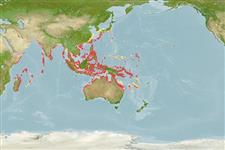Common names from other countries
Classification / Names / Names
Nomi Comuni | Sinonimi | Catalog of Fishes (gen., sp.) | ITIS | CoL | WoRMS
Environment: milieu / climate zone / depth range / distribution range
Ecologia
; distribuzione batimetrica 0 - 13 m (Ref. 349). Tropical
Indo-West Pacific: from East Africa, to Melanesia, but apparently not in the northwest Indian Ocean, the Red Sea nor the Persian Gulf, north to southern Japan and south to southern Queensland and New Caledonia.
Length at first maturity / Size / Peso / Age
Maturity: Lm ? range ? - ? cm Max length : 7.0 cm SHL maschio/sesso non determinato; (Ref. 349); common length : 5.0 cm SHL maschio/sesso non determinato; (Ref. 349)
Collected mainly for its shell, though occasionally eaten (Ref. 349). Found on intertidal sand flats (Ref. 799).
Life cycle and mating behavior
Maturità | Riproduzione | Deposizione | Uova | Fecundity | Larve
Members of the order Neotaenioglossa are mostly gonochoric and broadcast spawners. Life cycle: Embryos develop into planktonic trocophore larvae and later into juvenile veligers before becoming fully grown adults.
Poutiers, J.M. 1998. (Ref. 349)
IUCN Red List Status (Ref. 130435)
CITES status (Ref. 108899)
Not Evaluated
Not Evaluated
Threat to humans
Harmless
Human uses
Pesca: commerciale
| FishSource |
Strumenti
Informazioni ulteriori
Age/SizeAccrescimentoLength-weightLength-lengthMorfologiaLarveAbbondanza
Fonti Internet
Estimates based on models
Preferred temperature
(Ref.
115969): 24.8 - 29.3, mean 28.6 (based on 2656 cells).
Vulnerability
Low vulnerability (10 of 100).
Price category
Unknown.
